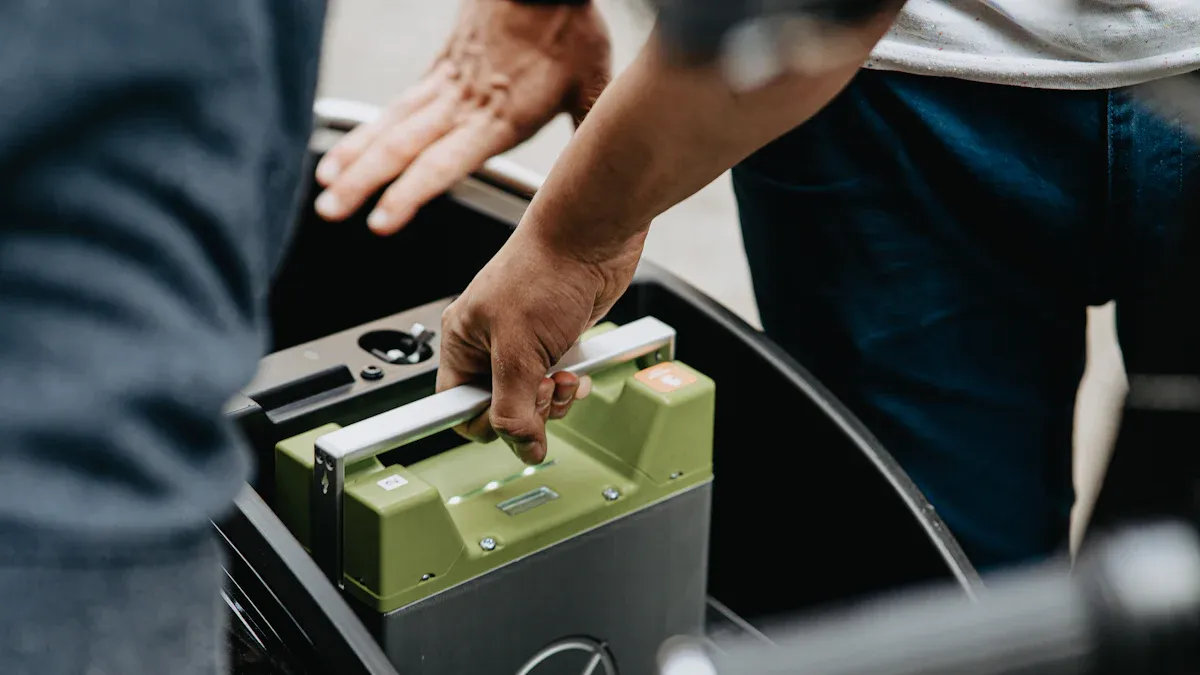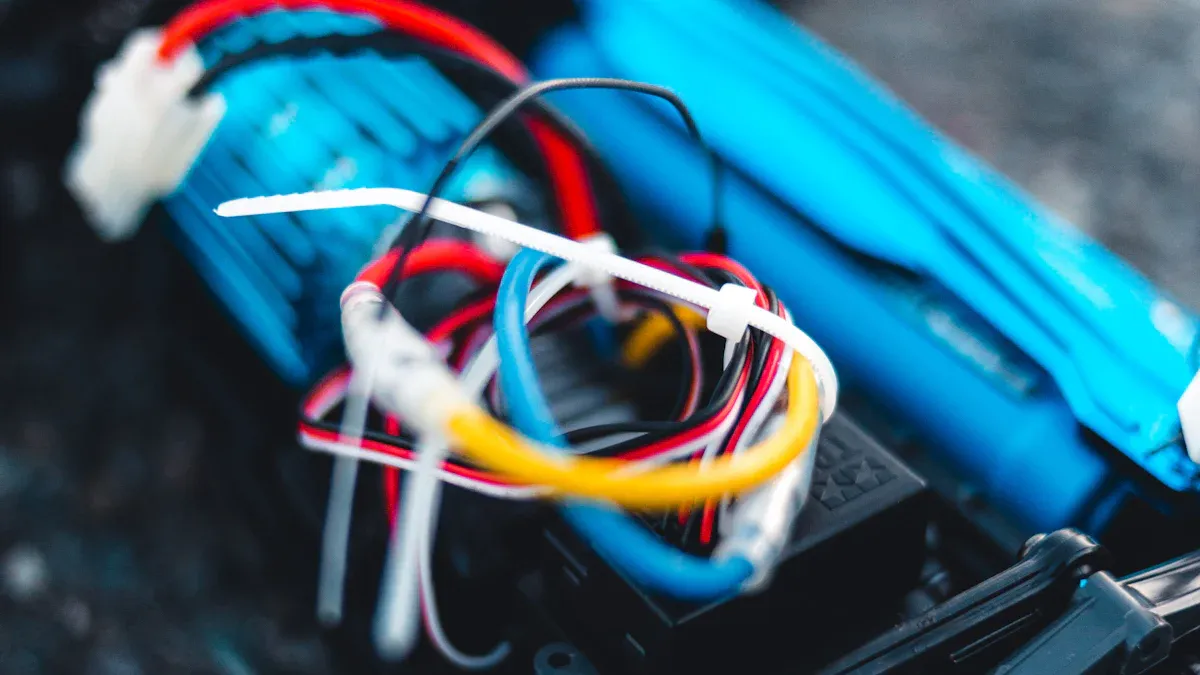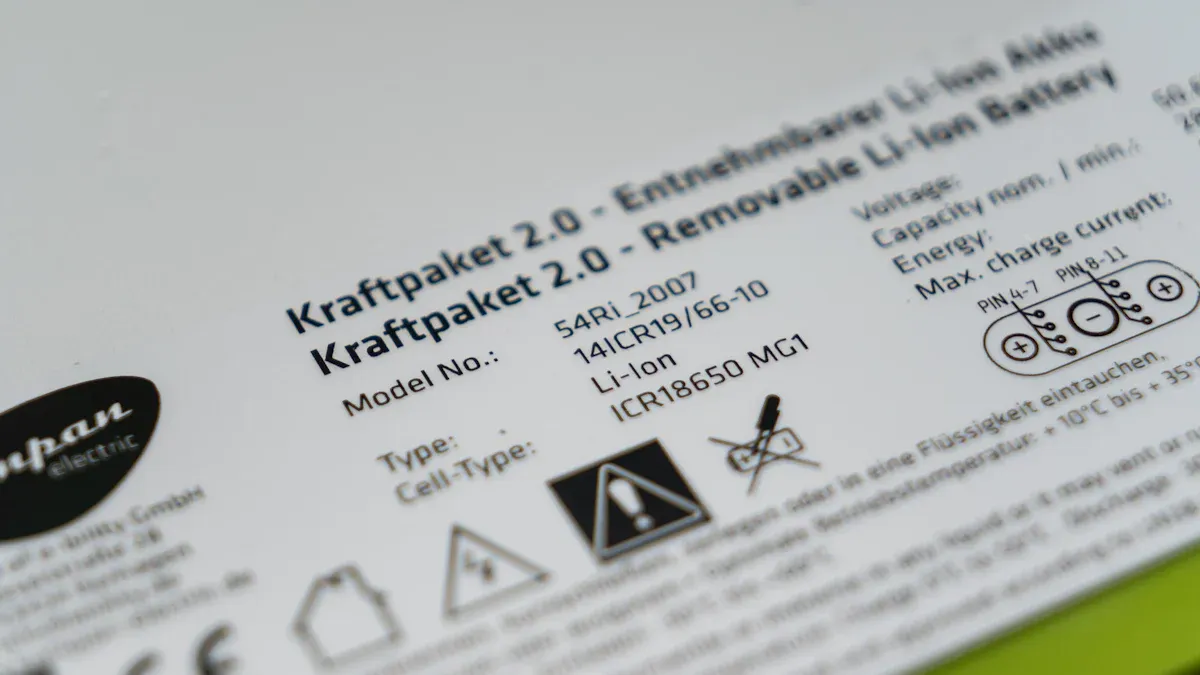
A 7.4v lithium battery charger helps you safely recharge batteries used in many everyday devices. You often find these batteries in robots, motor drivers, and similar electronics. Lithium battery chargers work with two main types: LiPo and Li-ion. Each battery needs a dedicated charger because different batteries have unique specifications for voltage and current. Using the correct 7.4v battery charger protects your battery and prevents damage. Pay attention to specifications, safety features, and proper usage. Choosing the right charger means your battery lasts longer and works better.
7.4V Lithium Battery Chargers

7.4V LiPo Battery Basics
A 7.4v lipo battery uses two 3.7V cells connected in series. This setup is called a 2S pack and gives you a total voltage of 7.4V. Lipo stands for lithium-polymer, which means the battery uses a flexible polymer electrolyte. You often see these batteries in drones, RC cars, and other devices where weight and shape matter. Lipo batteries are lightweight and can fit into small spaces. However, you must use a special charger for a 7.4v lipo battery. The charger needs to balance the charge between both cells. If one cell charges faster than the other, it can cause swelling or even fire. Always use lithium battery chargers designed for lipo chemistry to keep your battery safe and working well.
7.4V Li-ion Battery Overview
A 7.4v li-ion battery also uses two 3.7V cells in series. The main difference is the chemistry. Li-ion batteries use a liquid electrolyte and have a rigid, often cylindrical shape. These batteries are heavier and more durable than lipo batteries. You find 7.4v li-ion battery packs in laptops, power tools, and some electric vehicles. Charging lithium-ion batteries requires a charger that matches the battery’s voltage and chemistry. Li-ion batteries often include built-in protection circuits. These circuits help prevent overcharging and overheating. Even with these features, you should always use a 7.4v battery charger made for li-ion batteries.
Conseil : Never use a 12V charger for a 7.4v lipo battery or a 7.4v li-ion battery. The wrong charger can damage the battery or cause safety hazards.
How 7.4V Battery Chargers Work
Lithium battery chargers for 7.4V packs use a two-stage process. First, the charger uses constant current to fill the battery quickly. When the battery reaches its set voltage, the charger switches to constant voltage mode. This step tops off the charge and keeps the battery from overcharging. For a 7.4v lipo battery, balance charging is very important. The charger checks each cell and makes sure both cells charge evenly. This process helps prevent damage and extends battery life. Both 7.4v lipo battery and 7.4v li-ion battery packs need chargers with safety features like overcharge protection and automatic shut-off. Using the right charger for your battery type keeps you safe and helps your battery last longer.
| Fonctionnalité | 7.4V LiPo Batteries | 7.4V Li-ion Batteries |
|---|---|---|
| Type d'électrolyte | Polymer electrolyte, flexible shapes | Liquid electrolyte, rigid cells |
| Weight & Shape | Lightweight, flexible | Heavier, robust |
| Densité énergétique | Plus bas | Plus élevé |
| Stabilité thermique | Lower, needs careful charging | Higher, built-in protection |
| Durabilité | More fragile | More robust |
| Sécurité de la charge | Needs balance charger | Often has protection circuits |
| Applications | Drones, RC cars, portable electronics | Laptops, power tools, EVs |
Key Specifications

Voltage and Current
When you use a 7.4v lipo battery or a 7.4v li-ion battery, you need to pay close attention to voltage and current. The correct charger must deliver a voltage between 8.4V and 8.7V for a full charge. If you use a charger with the wrong voltage, you risk damaging the battery or reducing battery life. Always check the specifications on your battery and charger. The current rating also matters. A charger with too high a current can overheat the battery, while a charger with too low a current will take much longer to charge. Most lithium-ion batteries list a recommended charge current based on battery capacity. Following these specifications helps you protect battery life and keep your devices running safely.
Compatibilité
You must match your charger to the battery chemistry. Lithium-ion and lipo batteries need different charging profiles. Using the wrong charger can cause overheating, poor performance, or even battery failure. Many advanced chargers support both lithium-ion and lipo batteries. These chargers use intelligent battery management systems to detect the battery type and adjust the charge process. Battery management also includes temperature monitoring. If the battery gets too hot, the charger will slow down or stop charging. This feature protects the battery and extends battery life. Chargers with built-in battery management systems help you get the best performance from your lithium-ion batteries and keep your devices safe.
Remarque : Always check the specifications for your battery and charger before you start charging. Compatibility is key for safety and battery life.
Charge d'équilibre
Balance charging is essential for any 2S pack, such as a 7.4v lipo battery or a 7.4v li-ion battery. In a 2S pack, you have two cells connected in series. If one cell charges faster than the other, it can lead to overcharging or undercharging. This imbalance can shorten battery life or cause safety problems. A balance charger monitors each cell and makes sure both cells reach the correct voltage. This process keeps your battery healthy and improves battery capacity over time. Many lithium-ion chargers include balance charging as part of their battery management system. You should always use a charger with balance charging for 2S packs to protect your battery and get the most out of every charge.
| Spécifications | Pourquoi c'est important |
|---|---|
| Plage de tension | Prévient les surcharges et les dommages |
| Valeur nominale actuelle | Ensures safe, efficient charging |
| Compatibilité | Matches charger to battery chemistry |
| Charge d'équilibre | Keeps cells equal, extends battery life |
| Battery Management | Monitors health, temperature, and charge process |
Caractéristiques de sécurité
When you use a 7.4V lithium battery, you must pay close attention to safety features. These safety features protect you, your battery, and your devices from serious risks. Many problems can happen if you use the wrong charger or ignore important safety devices. Some of these problems include fire, explosion, or permanent battery damage. You can avoid most risks by understanding how each safety feature works and why it matters.
Protection contre les surcharges
Overcharge protection is one of the most important safety features in any lithium battery charger. If you charge a battery past its safe voltage, you increase the risk of fire or explosion. Overcharging can also cause the battery to swell or lose capacity. A good charger uses a protection circuit to stop charging when the battery reaches full voltage. This circuit checks the voltage of each cell and cuts off power at the right time. Many chargers also use battery management systems to monitor charging and prevent overvoltage. You should always use a charger with built-in overcharge protection to keep your battery safe.
Conseil : Never leave your battery charging unattended. Even with safety features, you should always watch for signs of overheating or swelling.
Temperature Monitoring
Temperature monitoring is another key safety feature. Lithium batteries can get hot during charging. If the temperature gets too high, the battery can catch fire or even explode. Some chargers have sensors that check the battery’s temperature during charging. If the battery gets too hot, the charger will slow down or stop charging. This safety device helps prevent thermal runaway, which is a dangerous chain reaction inside the battery. You should avoid charging your battery in very cold places, too. Charging below 32°F can damage the battery and increase risks. A protection circuit that monitors temperature keeps your battery safe in all conditions.
| Dispositif de sécurité | Ce qu'il fait |
|---|---|
| Protection contre les surcharges | Stops charging at full voltage |
| Temperature Monitoring | Checks battery heat and prevents overheating |
| Protection Circuit | Controls voltage, current, and temperature |
Short Circuit and Cutoff
Short circuit protection is a must-have safety feature in every lithium battery charger. A short circuit can happen if the battery terminals touch or if there is a fault in the wiring. This can cause a sudden surge of current, leading to fire or explosion. A protection circuit inside the charger will detect a short circuit and cut off the power right away. Automatic cutoff is another safety device that stops charging if anything goes wrong. This includes over-discharge, which happens when the battery voltage drops too low. If the voltage falls below 2 volts, the battery can suffer permanent damage or even cause a short circuit inside. Battery management systems use these safety features to keep your battery safe from all kinds of risks.
Remarque : Using a charger without proper safety features puts you and your devices at risk. Always check for protection circuits and battery safety devices before charging.
Common Causes of Charger Failures and How to Prevent Them
- Using the wrong charger can cause overcharging, swelling, or even fire.
- Charging batteries below 32°F can lead to permanent damage.
- Letting the battery voltage drop below 2 volts can cause short circuits and loss of capacity.
- Overheating from overcharging or high temperatures can result in thermal runaway.
You can prevent these problems by choosing a charger with strong safety features. Look for protection circuits, temperature monitoring, and automatic cutoff. Battery management systems add another layer of safety by checking for overvoltage, overheating, and other risks. These safety devices work together to protect your battery and give you peace of mind.
Using a 7.4V Battery Charger
Charging Steps
You can safely charge your 7.4V lithium battery by following these steps:
- Place your battery on a non-flammable surface in a cool, ventilated area.
- Connect the battery to a dedicated charger that matches the battery’s voltage and current specifications.
- If your battery is a 2S pack, use the balance charging port to ensure both cells charge evenly.
- Set the charger to the correct mode for your battery type (LiPo or Li-ion).
- Start the charge and monitor the process. Watch for any signs of swelling or overheating.
- Unplug the battery once it reaches full charge. Do not leave it connected longer than needed.
Conseil : Always check the battery’s voltage before charging. If you see a cell below 2.5 volts, use a specialized charger with a revive function to try to recover it. If the cell heats up or loses charge quickly, recycle it for safety.
Meilleures pratiques
You can extend battery life and improve safety by following these best practices:
- Keep the battery charge between 20% et 80%. This 20-80 rule helps reduce stress on the battery and keeps battery life longer.
- Avoid charging and discharging the battery fully. Extreme levels can damage the battery capacity.
- Charge the battery at room temperature, ideally between 10°C and 30°C.
- Do not use damaged batteries. Swollen or punctured batteries are unsafe.
- Store the battery at 40-60% charge in a cool, dry place for long-term storage.
Troubleshooting
If you notice problems during charging, take these steps:
- Check each cell’s voltage. If a cell drops below 2.5 volts, it may be unsafe to use.
- Try to revive the cell with a charger that has a low current setting. Raise the voltage above 2.8 volts before switching to normal charging.
- After charging, test the battery by discharging it at a low current and measuring battery capacity.
- If the battery self-discharges quickly, heats up, or shows low battery capacity, recycle it.
- Always use chargers designed for lithium batteries and follow all safety instructions.
Remarque : Common mistakes include overcharging, using the wrong charger, charging in extreme temperatures, and leaving batteries unattended. You can avoid these by following the steps above and always putting safety first.
Top Lithium Battery Chargers
Model Comparison
When you look for a charger for your 7.4V lithium battery, you will find several popular models. The Tenergy TB6B stands out because it supports many battery types and offers multiple charge modes. You can use it with NiMH, NiCd, LiPo, Li-ion, LiFePO4, and SLA batteries. The SKYRC iMAX B6 series is another top choice. Many users recommend it for 7.4V (2S) lithium batteries. It offers balanced charging, storage modes, and automatic stop. Some users also choose HTRC B6 V2 Balance Charger as a budget-friendly option. These models give you flexibility and safety for your battery.
| Feature/Specification | Tenergy TB6B | SKYRC iMAX B6 Series |
|---|---|---|
| Battery Types Supported | NiMH, NiCd, LiPo, Li-ion, LiFePO4, SLA | NiMH, NiCd, LiPo, Li-ion, LiFePO4 |
| Charge Modes | Multiple charge modes, balancing, storage | Multiple charge modes, balancing |
| Max Charge Power | 50W | 50W |
| Display | LCD screen | LCD screen |
| Power Input | AC/DC (car battery support) | AC/DC |
Features Overview
You want a charger that gives you control and keeps your battery safe. The Tenergy TB6B offers multiple charge modes, including balancing, fast charging, and storage. You can store up to five charging profiles. The charger supports many connectors, so you can use it with different devices. The LCD screen makes it easy to check charging status and modes. The SKYRC iMAX B6 series also gives you several modes, such as balance, fast, and storage. Both chargers let you use balance connectors for safe charging. You can power these chargers from a wall outlet or a car battery, which helps when you need to charge outdoors.
Always inspect your battery before charging. Use balance charge mode for LiPo packs to keep both cells healthy.
User Recommendations
If you use RC cars, drones, or general electronics, you need a charger with multiple charge modes and strong safety features. The SKYRC iMAX B6 series is the most trusted by experienced users. It works well for 7.4V lithium batteries and gives you reliable modes for every need. The Tenergy TB6B is a good alternative if you want more connector options and data storage. For a lower-cost choice, you can try the HTRC B6 V2. Always choose a charger that matches your battery type and supports balance charging. This helps your battery last longer and keeps your devices safe.
Choosing the right 7.4V lithium battery charger keeps your LiPo and Li-ion batteries safe and long-lasting. Look for these features when you select a charger:
- Utiliser le CC-CV charging method for safe and full charging.
- Pick a charger that matches your battery’s current and voltage ratings.
- Make sure the charger has temperature monitoring and automatic cut-off.
- Set charging limits with built-in controls or microcontroller settings.
- Prefer chargers with in-line safety checks and programmable timers.
Always read your battery manual and ask an expert if you feel unsure. Your safety comes first! 🔋
FAQ
What makes a 7.4v lithium battery charger different from other chargers?
You need a 7.4v battery charger because it matches the voltage and current specifications of your battery. Using the wrong charger increases risks like fire or explosion. Dedicated lithium battery chargers include safety features and protection circuits for safe charging and discharging.
Can you use the same charger for both 7.4v lipo battery and 7.4v li-ion battery?
You should not use the same charger for both types unless the charger supports multiple charge modes and chemistries. Lithium-polymer and lithium-ion batteries require different charging profiles. Always check compatibility and use a charger with a battery management system.
Why is balance charging important for 7.4v lithium-ion batteries?
Balance charging keeps both cells in your 2S pack at equal voltage. This process prevents overcharging, improves battery capacity, and extends battery life. Chargers with balance charging and a battery management system help avoid safety risks and protect your battery.
What safety features should you look for in a lithium battery charger?
Look for overcharge protection, temperature monitoring, and short circuit cutoff. A good charger uses a protection circuit and other safety devices to prevent fire, explosion, and damage. These features improve battery safety and battery life.
How do you safely charge and store a 7.4v lithium battery?
Always charge your battery on a non-flammable surface. Store it at 40-60% charge in a cool, dry place. Avoid charging and discharging fully. Use a charger with multiple charge modes and a battery management system for best safety.

